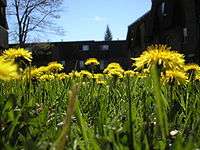Raunkiær plant life-form
The Raunkiær system is a system for categorizing plants using life-form categories, devised by Christen C. Raunkiær and later extended by various authors.
History
It was first proposed in a talk to the Danish Botanical Society in 1904 and briefly described in the society's journal Botanisk Tidsskrift.[1][2]
A fuller account appeared in French the following year.[3] Raunkiær elaborated further on the system and published this in Danish in 1907.[4][5]
The original note and the 1907 paper were much later translated to English and published with Raunkiær's collected works.[2][5][6]
Modernization
Raunkiær's life-form scheme has subsequently been revised and modified by various authors,[7][8][9] but the main structure has survived.
Subdivisions
The subdivisions of the Raunkiær system are based on the place of the plant's growth-point (bud) during seasons with adverse conditions (cold seasons and dry seasons):
Phanerophytes
Projecting stems into the air – normally woody perennials - with resting buds more than 25 cm above soil level, e.g. trees and shrubs, but also epiphytes, which Raunkiær separated out as a special group in later versions of the system.
Further subgrouping
Raunkiaer further subdivided the phanerophytes according to height as megaphanerophytes, mesophanerophytes, microphanerophytes, and nanophanerophytes. Other characters used to further subdivide were duration of leaves (evergreen or deciduous) and presence of covering bracts on buds (eight classes in all). Three further classes, phanerophytic stem succulents, phanerophytic epiphytes, and phanerophytic herbs brought the number of subclasses to 12.
Chamaephytes
Buds on persistent shoots near the ground – woody plants with perennating buds borne close to the ground, no more than 25 cm above the soil surface, (e.g., bilberry and periwinkle).
Hemicryptophytes

Buds at or near the soil surface, e.g. daisy, dandelion.
- Protohemicryptophytes
- only stem leaves
- Partial rosette plants
- both stem and basal rosette leaves
- Rosette plants
- only basal rosette leaves
Cryptophytes

Below ground or under water - with resting buds lying either beneath the surface of the ground as a rhizome, bulb, corm, etc., or a resting bud submerged under water. Cryptophytes are divided into 3 groups:
- Geophytes
- Resting in dry ground, e.g. crocus, tulip. May be further subdivided into rhizome, stem-tuber, root-tuber, bulb and root geophytes.
- Helophytes
- Resting in marshy ground, e.g. reedmace, marsh-marigold.
- Hydrophytes
- Resting by being submerged under water, e.g. water-lily, frogbit.
Therophytes
Annual plants which complete their life-cycle rapidly under favorable conditions and survive the unfavorable cold or dry season in the form of seed. Many desert plants are by necessity therophytes.
Epiphytes
Epiphytes were originally placed in Phanerophytes (above) but then separated because of irrelevance of soil position.
Aerophytes

A later addition to the Raunkiær lifeform classification.[10] Plant that obtains moisture and nutrients from the air and rain; usually grows on other plants but not parasitic on them. These are perennial plants whose roots atrophy; some can live on mobile sand dunes; like epiphytes and hemicryptophytes, their buds are near the surface. This group includes some but not all Tillandsia species.
References
- ↑ Raunkiær, C. (1904), "Meddelelser om biologiske Typer, med Hensyn til Planternes Tilpasninger til at overleve ugunstige Aarstider (5 December 1903 and 9 January 1904)", Botanisk Tidsskrift, 26: XIV–XV
- 1 2 Ch. 1 in Raunkiær (1934): Biological types with reference to the adaption of plants to survive the unfavourable season, p. 1.
- ↑ Raunkiær, C. (1905) Types biologiques pour la géographie botanique. Oversigt over Det Kongelige Danske Videnskabernes Selskabs Forhandlinger, 1905, 347-438.
- ↑ Raunkiær, C. (1907) Planterigets Livsformer og deres Betydning for Geografien. Gyldendalske Boghandel - Nordisk Forlag, København and Kristiania. 132 pp., (PDF).
- 1 2 Ch. 2 in Raunkiær (1934): The life-forms of plants and their bearings on geography, p. 2-104.
- ↑ Raunkiær, C. (1934) The Life Forms of Plants and Statistical Plant Geography, being the collected papers of C. Raunkiær. Translated by H. Gilbert-Carter, A. Fausbøll, and A. G. Tansley. Oxford University Press, Oxford. Reprinted 1978 (ed. by Frank N. Egerton), Ayer Co Pub., in the "History of Ecology Series". ISBN 0-405-10418-9. Note: These are not all of Raunkiaer's publications, only those on plant form and geography.
- ↑ Ellenberg. H. & D. Mueller-Dombois (1967). A key to Raunkiaer plant life-forms with revised subdivisions. Ber. Goebot. Inst. ETH. Stiftg Rubel. Zurich. 37:56-73, .
- ↑ Müller-Dombois, D. & H. Ellenberg (1974) Aims and methods in vegetation ecology. John Wiley & Sons, New York. Reprint 2003, Blackburn Press, ISBN 1-930665-73-3
- ↑ Shimwell, D.W. (1971) The Description and Classification of Vegetation. Sidgwick & Jackson, London. ISBN 9780283980633
- ↑ Galán de Mera, A., M. A. Hagen & J. A. Vicente Orellana (1999) Aerophyte, a New Life Form in Raunkiaer's Classification? Journal of Vegetation Science 10 (1): 65-68